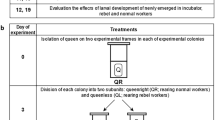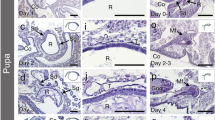Summary
The glucose levels in homogenates of heneybee brood (5th–16th day of life) and in the jelly of each caste (5th–9th day of life) were determined.
The glucose level of workers was, during the majority of days tested, up to twice as high as in queens, the most impressive changes in the glucose level occurred during the 5th–8th days of life, at which time there was a parallel rise in the glucose levels of worker homogenate and of the jelly which serves as their food. No such rise was observed in queen brood homogenate.
Résumé
Nous avons mesuré les taux de glucose d'homogénats de couvain d'Abeilles (du 5e au 16e jour de vie larvaire) et de la gelée royale distribuée à chaque caste (du 5e et 9e jour de vie larvaire).
La majorité des jours où les mesures furent réalisées, le taux de glucose des larves d'ouvrières s'éleva jusqu'à deux fois celui des larves de reine. Les changements les plus marqués dans les taux de glucose furent obtenus du 5e au 8e jour de vie larvaire. Durant cette période, l'augmentation des taux de glucose fut parallèle dans les homogénats de larves d'ouvrières et dans la gelée dont elles se nourrissaient. Rien de tel ne fut observé dans les homogénats de couvain de reine.
Similar content being viewed by others
References
Brian (M. V.) andKelly (A. F.), 1967. — Studies of caste differentiation inMyrmica rubra L.Ins. Soc., 14, 13–24.
Brunet (P. C. J.), 1965. — The metabolism of aromatic compounds.In Aspects of Insect Biochemistry (T. W. Goodwin, ed.), pp. 49–77. Academic Press, édit., London.
Butler (C. G.), 1960. — Sex determination and caste differentiation in the honeybee (Apis mellifera). Memoir No. 7,Soc. Endocr., 3–8.
Fischl (J.) andIshay (J.), 1972. — The glucose levels and carbohydrate autolysis inVespa orientalis.Ins. Soc., 18, 203–214.
Gösswald (K.) andBier (K.), 1957. — Untersuchungen zur Kastendetermination in der GattungFormica.Ins. Soc., 4, 335–348.
Fischl (J.), Ishay (J.) andRutenberg (A.), 1974. — Poly- and disaccharidases activity inVespa orientalis (Vespinae, Hymenoptera).Comp. Biochem.-Physiol., 48B, 299–306.
Flanders (S. E.), 1962. — Physiological prerequisites of social reproduction in the Hymenoptera.Ins. Soc., 9, 375–388.
Hanser (G.) andRembold (H.), 1960. — Ueber den Weiselzellenfuttersaft der Honigbiene. IV. Jahreszeitliche Veranderungen im Biopteringehalt des Arbeiterinnenfuttersaftes. Hoppe-Seyler's Zeits.Phys. Chem. Bd., 319, 200–205.
Ishay (J.), 1975. — Caste determination by social wasps: Cell size and building behaviour.Anim. Behav., 23, 425–431.
Ishay (J.), Gitter (S.) andFischl (J.), 1973. — Gluconeogenesisin vitro inVespa orientalis hemolymph.Proc. VIIth Int. Cong. Social Insects, London, 165–175.
Ishay (J.), Fischl (J.) andRutenberg (A.), 1974. — Glucose levels as caste indicator of the honeybee.Experientia, 30, 1381–1382.
Lindauer (M.), 1965. — Social behaviour and mutual communication. The Physiology of Insecta, 2, pp. 173–186. Academic Press Inc., édit., New York.
Lüscher (M.), 1961. — Social control of polymorphism in termites.In Insect Polymorphism (Y. S. Kennedy, editor), pp. 57–67. Roy Entomol. Soc., édit., London.
Maurizio (A.), 1962. — Zuckerabbau unter der einwirkung der invertierenden fermente in Pharynxdruesen und Mitteldarm der Honigbiene (Apis mellifica L.).Ins. Soc., 9, 39–72.
Rembold (H.), 1973. — Chemical basis of honeybee caste formation.Proc. VIIth Int. Cong. Social Insects, London, 327–328.
Shuel (R. W.) andDixon (S. E.), 1973. — Regulatory mechanisms in caste development in the honeybee.Apis mellifera L.Proc. VIIth Int. Cong. Social Insects, London, 349–360.
Spradbery (J. P.), 1973. — Wasps. Sidgwick and Jackson, édit., London, 408 p.
Tsao (W.), 1972. — Relationship of haemolymph and fat body carbohydrate to caste and diet in female honeybee larvae.Apis mellifera L.Ph. D. Thesis, Univ. of Guelph, Canada.
Wheeler (W. M.), 1928. — The social insects, their origin and evolution. Harcaurt Brace and Co., édit., New York, 378 p.
Wilson (E. O.), 1971. — The Insect Societies. Harvard University Press, édit., Cambridge, Mass., 548 p.
Winz (P.), 1973. — Differentiation in the honeybee larvae. A histological electronmicroscopical and physiological study of caste indication inApis mellifera mellifera L.Ph. D. Thesis., Com. Agri. Univ. Wageningen No. 73-5, 155. p.
Author information
Authors and Affiliations
Rights and permissions
About this article
Cite this article
Ishay, J., Fischl, J. & Alpern, G. Study of honeybee caste differentiation by glucose level differences during development. Ins. Soc 23, 23–28 (1976). https://doi.org/10.1007/BF02283903
Received:
Accepted:
Issue Date:
DOI: https://doi.org/10.1007/BF02283903




